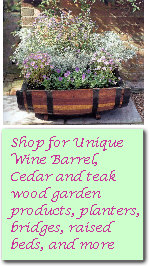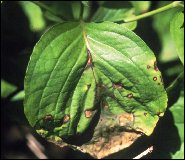The geographical range of dogwood anthracnose is alarmingly
extensive for both its North American host trees. The disease first appeared in
1976 on the mountain dogwood in the Vancouver area of Washington State. Until
1981, its spread had been limited to that state, but by 1983 the disease was
reported in Oregon and British Columbia, as well as in one county in Idaho. By
1994, dogwood trees in northern California were affected.
Anthracnose was first reported on the flowering dogwood in
1983 in New York, Connecticut, Pennsylvania, and New Jersey. By 1987, the
disease had spread north and south, to Massachusetts, Delaware, Maryland,
Virginia, and West Virginia. By 1988, it was traced south, primarily along the
Appalachian mountain range, and was discovered in high-elevation sites and cool,
wet valleys in Georgia, North Carolina, and Tennessee. It was confirmed in
Kentucky and Alabama in 1989, Ohio and the District of Columbia in 1990, New
Hampshire in 1991, Rhode Island in 1992, Indiana, Vermont, and Michigan in 1993,
and Missouri in 1994. Some confirmed cases in these states have been attributed
to movement of dogwood nursery stock from areas with the disease. Even the
non-native Korean dogwood (Cornus kousa), usually resistant to
anthracnose, can suffer leaf infection when moisture conditions especially favor
the disease.
Enigmatic Fungus
Public concern and research has been greatest in the eastern
United States, not surprisingly, considering flowering dogwood (C. florida)
and its many cultivars are highly valued ornamental trees important to the
nursery and landscape gardening industries.
Soon after the first reports of dogwood anthracnose, a fungal
pathogen in the genus Discula was identified as the cause. In 1991, the
pathogen was fully described and named Discula destructiva. Dogwood
anthracnose had not been reported in pre-1970s surveys of dogwood diseases, and
examination of herbarium specimens of Cornus species found no evidence of
it prior to that time. Because of its sudden and coincidental appearance near
ports of entry, specifically Seattle in the West and New York in the East, as
well as its rapid spread and resulting widespread destruction, the disease is
suspected of being an introduced pathogen. So far there is no evidence on
Cornus hosts native to countries outside North America. For now, the origin
of dogwood remains a mystery.
Symptoms
Some infected dogwoods, especially in shaded woodland
conditions, are killed in one to three years. Others in sun-exposed sites often
survive and, depending on moisture conditions, exhibit symptoms of varying
severity year to year. Dogwood anthracnose affects all above-ground parts of the
host tree: leaves, bracts, current-year shoots, trunk sprouts, bark and cambium,
fruits and seeds.
Leaf symptoms are first noted on newly opened leaves in
spring. Three kinds of leaf symptoms may develop: leafspot, blotch, and blight.
Leafspots are localized dead or discolored areas scattered in the leaf blade.
Blotch refers to irregular dead patches often observed on tips or along leaf
margins. Blighting, the death of the entire leaf blade, commonly occurs
throughout the canopy of infected dogwoods in shady areas, or within the lower,
shaded part of the canopy of those in sun-exposed sites. Blighted leaves become
withered and sometimes remain attached to branches throughout the winter. Even
bracts can show telltale symptoms of the disease: reddish purple spots or brown
blotches.
Twig dieback occurs when infection advances from blighted
leaves directly into the stems. Twig death tends to be concentrated in the lower
branches of dogwoods, hence the early name of the disease, "lower branch
dieback." Epicormic branches (clusters of sprouts) appear on the trunk and main
branches following dieback; these are readily infected, and infection spreads
from them into the trunk and main branches, where it causes cankering (localized
dead areas in the bark and cambium).
An understanding of how environmental conditions affect
dogwood anthracnose has helped researchers develop control practices. Sunlight
and moisture are the most important influences. Anthracnose is more severe, and
tree mortality is greater, on dogwoods in the shade. In full sun, symptoms are
more severe in the lower branches than in the upper, exterior canopy, and
infected trees often recover with proper maintenance.
Dogwood anthracnose thrives in moist conditions. For dogwoods
in the Northeast, leaf symptoms begin to appear following leaf expansion,
provided there is enough rainfall to keep the leaves wet for several hours at a
time. Foliar infection can recur throughout the summer except during very dry
periods. Moisture is also key to the production of fungus spores, which emerge
from pinhead-sized fruiting bodies on dead leaf and twig tissues of infected
dogwood. Under moist conditions, blighted dogwood leaves that often remain
hanging over winter are a source of spores for new infections in the spring.
Most short-distance dispersal of the fungus within and among
trees is thought to occur via wind driven and splashing rain. Seed-carrying
birds are also suspected of being carrier of dogwood anthracnose since the
fungus has been isolated from fruit and seed of infected dogwoods.
During the onset of severe dogwood anthracnose in the late
1970s and early 80s in the Northeast, almost all dogwoods became infected
regardless of tree health prior to infection. For infected dogwoods, however,
any additional stresses like droughts or low fertility reduce tree vigor and
hasten tree decline.
Resistant Trees
The greatest hope for long-term management of dogwood
anthracnose is the discovery of genetic resistance in this host. Surviving
seedlings of C. florida in woodland sites have been identified as
candidates for resistant stock; eight were discovered in Catoctin Mountain Park,
MD, in 1991 - 1992. Clones and seed progeny of these selections are being
subjected to high disease pressure by University of Tennessee researchers Dr.
Effin Graham and Dr. Mark Windham to confirm their resistance. I have also
identified potentially resistant survivors from a population of C.
florida devastated by anthracnose in the late 1970s in the Mohonk Preserve,
New Platz, NY; I am currently testing them for susceptibility and resistance to
anthracnose. Other species of Cornus that have shown resistance to
anthracnose are the North American native C. racemosa and C.
canadensis, as well as non-native C. amomum, C.
alternifolia, and C. mas.
The non-native C. kousa, which has large floral
bracts similar to C. florida, can show leaf symptoms under
moisture conditions especially favorable for the fungus, but this dogwood is
considered relatively resistant to anthracnose. The cultivar C. kousa
var. chinensis, selected for its larger bracts, carries similar
resistance. Hybrids of C. florida x C. kousa,
released as the Stellar series by Rutgers University, also produce showy bracts
and have exhibited resistance to anthracnose in ongoing field tests. Their
trademarked names are Ruth Ellen, Constellation, Aurora, Galaxy, Stardust, and
Stellar Pink. Except for Stellar Pink, all bloom with white floral bracts about
the size of those of flowering dogwoods, blossoming on the heels of this native
species.
In the Future
In southwestern New York, the damage to flowering dogwoods
from anthracnose is far less severe today than during the 1980s. Many landscape
and roadside dogwoods have recovered from earlier infection, and leaf symptoms
often are limited to scattered spots and blotches. Epicormic branches and new
annual cankers appear less often. This apparent trend of decreasing disease
severity in one region is puzzling and inconsistent with other introduced
diseases in North American forest trees, most notably chestnut blight and Dutch
elm disease. There are plausible explanations for this apparent decrease of
anthracnose: environmental conditions in the Northwest may have become
unfavorable for the disease or some as yet unidentified change may have occurred
in the pathogen itself. Anthracnose is still having an impact on C.
florida in some areas at the southern edge of its range, and on C.
nuttallii in the West.
The long-term effects of anthracnose on native dogwood
populations, and on the wildlife they support, are not known. In woodland sites
in Maryland and New York, where mortality of dogwoods was high over a decade
ago, dogwoods are surviving, some bearing viable seed. Researchers are
monitoring the sites for any natural regeneration of dogwood by seedlings
For more information on dogwood anthracnose, check out these
related links:
USDA Forest Service
NAPIS
Dr. Craig R. Hibben
was a research plant pathologist and chairman of BBG Research Center, Ossining,
NY, conducting much of the original research on dogwood anthracnose in the
Northeast. After retiring he became a research associate at Mononk Preserve, New
Paltz, NY, and at Lasdon Park and Arboretum, Somers, NY, and a research
consultant at NY Botanical Garden. This article is based on: M. L. Daughtrey, C.
R. Hibben, K. O. Britten, M. T. Windham and S. C. Redlin, 1996, "Dogwood
Anthracnose: Understanding a Disease New to North America," Plant Disease
80:349-358.
![]() Gardeners' Corner
Kids'
Garden
Sustainable Garden
Contact Us
Gardeners' Corner
Kids'
Garden
Sustainable Garden
Contact Us![]()


